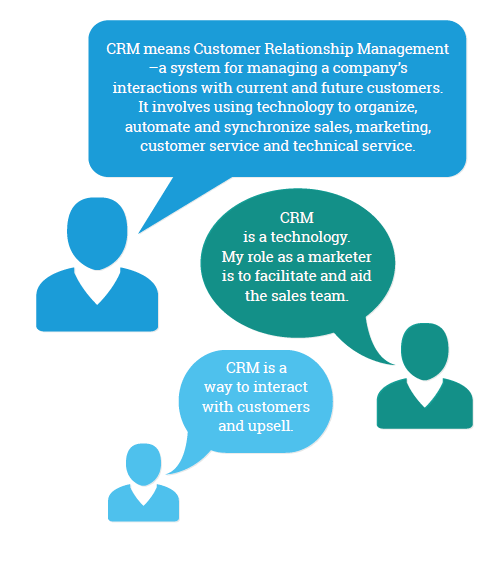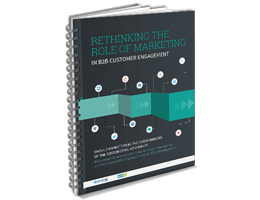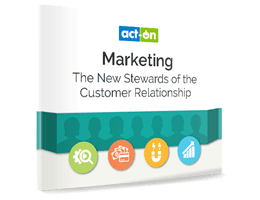 If you’re lucky, your business has a lot of customers. And if you’re really lucky, you’re connecting and communicating with them in many different ways over the span of your relationship.
If you’re lucky, your business has a lot of customers. And if you’re really lucky, you’re connecting and communicating with them in many different ways over the span of your relationship.
Managing, understanding, and optimizing every experience your customers have with your brand is important – and it’s also problematic. Throughout every stage of the customer lifecycle, and across every channel and point of contact, there may be hundreds (if not thousands) of different variables at play. And it’s likely there are different teams making and managing those customer connections. For most B2B companies, there are gaps and disconnects between and among those teams.
You probably don’t have to imagine the issues that arise from this level of disconnect – because it’s likely that you see them in your own organization all the time. Common scenarios:
- Customer service hasn’t been told that the marketing team is sending an email campaign promoting a discount, so service reps can’t respond to customer questions about redeeming the offer.
- A regional sales team isn’t told that the events team is planning a conference in their territory, and customers are being invited to two different events run by the same company.
- The social media team is unaware that human resources recruiters are posting job listings using a Twitter account that’s not intended for corporate communications.
- The web team wasn’t told about a massive branding shift until the eleventh hour.
These sorts of things happen at every company to one degree or another, and I’ll bet you have your own war stories.
The short-term results of this uncoordinated communication? Muddled messages and contradictory or duplicated efforts across the organization. And confused, disengaged customers. The long term results are even worse – this kind of disjointed experience can drive customers away.
In most cases, no single team has the visibility necessary to see every customer interaction. Add to that the fact that in most companies, no one is charged with the responsibility to use that insight to create a continuous, engaging journey for the customer. This means missed opportunities – and lost revenue – for most B2B companies.
Marketing’s responsibilities (and its potential) have increased greatly, spurred by technological and societal changes. Already, in forward-thinking, top-performing organizations, traditional roles are evolving to meet the needs of today’s customer-centric marketplace. Marketing’s influence on the spectrum of lifecycle stages is increasing, softening the delineations between steps and stages. But is this shift happening fast enough? Are B2B companies missing opportunities to drive more satisfying, more profitable relationships – for both the buyer and the seller?
To find out, Gleanster Research and Act-On Software conducted a comprehensive study to understand the state of customer lifecycle engagement, CRM, and what separates Top Performing organizations from Average firms in midsized B2B organizations. The surprising results of the survey are presented in the new report, Rethinking the Role of Marketing in B2B Customer Engagement.
What is the Real Meaning of CRM?
 One of the purposes of this study was to gain a better understanding of the role of marketers in customer relationship management (CRM). As it turns out, CRM can mean many things to many people. When asked “How do you define CRM?” and allowed to choose more than one answer, marketers had the following responses:
One of the purposes of this study was to gain a better understanding of the role of marketers in customer relationship management (CRM). As it turns out, CRM can mean many things to many people. When asked “How do you define CRM?” and allowed to choose more than one answer, marketers had the following responses:
- 57% said CRM is strategy to interact with customers
- 45% described it as a process for monitoring and analyzing data
- 42% indicated it as technology that automates the sales force
- 34% decided it was a department that manages the relationship between the company and a customer
It’s pretty clear that there’s still some debate, although two options, viewing CRM as a strategy or a process came out ahead (although not by much). This is good news, because marketers are clearly starting to see CRM as more than a siloed department or a technology that’s used only by the sales team.
Three Key Findings
Overall, the study found that the most successful organizations take a holistic approach to engaging with the customer – with marketers playing the pivotal role. The three key findings of the report highlight this conclusion:
- Average companies focus too much on acquisition and not enough on retention. If marketing objectives are tied to the number of leads the team generates, that’s where marketers are going to spend their time and money. Customer satisfaction metrics should be an ongoing metric of success for customer lifecycle optimization.
- The customer lifecycle needs a leader. Marketing is well-positioned to play this role, as they’re the only ones with the technology and the visibility to measure qualitative and quantitative efforts across the entire lifecycle, in the context of the customer.
- Marketing technology is the central conduit for monitoring, measuring, and engaging with customers across the entire customer lifecycle. When integrated with sales and service, marketing tools can gather data about customer relationships and communicate with them based on lifecycle stage or behavior.
The survey findings illustrate significant opportunities for improvement for mid-size B2B marketing organizations when it comes to developing customers relationships.
 Does your company need to rethink the customer lifecycle? Download the Gleanster/Act-On report to learn about the significant differences between Top Performing businesses and Average companies, and find out if your organization is leaving money on the table … by leaving customers out in the cold.
Does your company need to rethink the customer lifecycle? Download the Gleanster/Act-On report to learn about the significant differences between Top Performing businesses and Average companies, and find out if your organization is leaving money on the table … by leaving customers out in the cold.
 Once you’re ready to put these ideas into action, read this eBook and discover the five tactics to help transform your business from a series of customer hand-offs into an end-to-end customer lifecycle engagement continuum. Start getting the same results that Top Performing organizations are seeing by using these real-world tactics and success strategies from Act-On customers.
Once you’re ready to put these ideas into action, read this eBook and discover the five tactics to help transform your business from a series of customer hand-offs into an end-to-end customer lifecycle engagement continuum. Start getting the same results that Top Performing organizations are seeing by using these real-world tactics and success strategies from Act-On customers.
